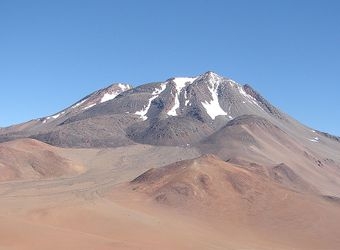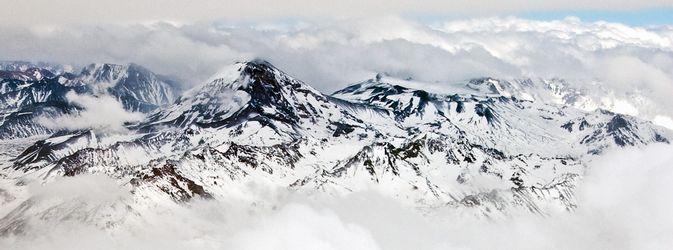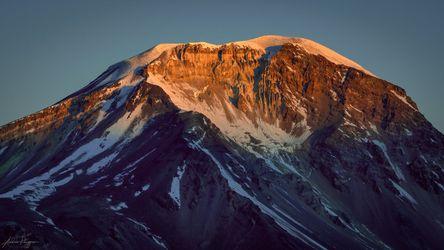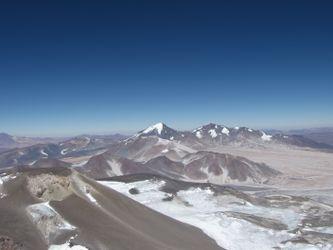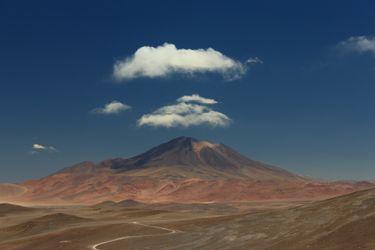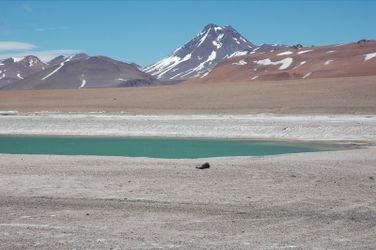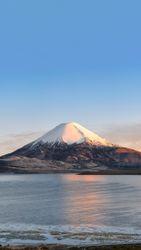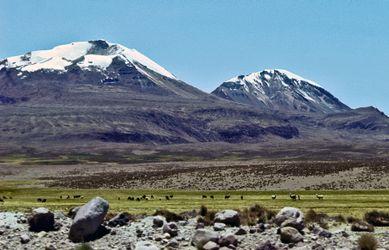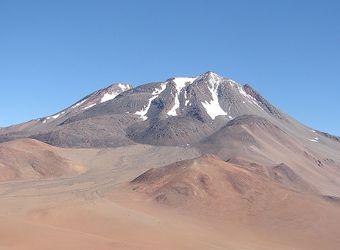Why climb in Chile
Chile's unique lunar landscape distinguishes it from other Andean countries. Climbs aren't technical, but still stand out: Aconcagua the biggest peak in both South America and outside of Asia is a short drive over the Andes, Ojos del Salado the tallest Volcano, plus some other out of the way adventures like Llullaillaco.
It's a very developed country, with a range of high value guide services. Base camps and logistics are well arranged. Flying in to Santiago is generally quite easy, with several good acclimitsation peaks near by. Plenty of nice hikes south in Patagonia for after your climb if you have time...
When to climb in Chile
- December to October
The best time to climb 6000+ meter peaks in Chile is during the austral summer, from December to March, when weather conditions are more stable and temperatures are milder.
The northern Atacama region is defined by extreme temperature variations between day and night, as well as strong winds
In the Central Andes, summer provides the most favorable conditions, but sudden weather changes and high-altitude storms aren't uncommon.
Where to climb in Chile
In Chile, the main clusters of 6000+ meter peaks are found in the Atacama region and the Central Andes.
The Atacama region is home to the Ojos del Salado, the world's highest active volcano at 6,893 meters, along with other notable peaks like Nevado Tres Cruces - several of which can be done together in one tiring expedition. These are remote peaks.
The Central Andes feature prominent mountains such as Cerro Tupungato, Marmolejo, and across the border Aconcagua. All accessed from the capital Santiago.
Climbs in Chile
Most popular
The classic climbs in Chile:
Lesser known
Escape the crowds and get of the beaten path in Chile with these climbs:
All climbs in Chile
The Ojos del Salado is a fascinating ascent for any dedicated mountaineer eager to test their skills on the world's tallest active volcano. Straddling the border between Argentina and Chile, it towers at an impressive height of 6,893 meters, making it the highest summit in Chile and the second highest in the Western Hemisphere. The mountain offers a unique combination of challenges, including high altitude and extreme weather conditions, which demand respect and careful preparation. The route is typically approached from the Chilean side, with the climb often starting from the Atacama Desert, adding a distinct arid environment to the experience.
Climbing Ojos del Salado requires a solid understanding of high-altitude mountaineering, as the air becomes thin and the weather can be unpredictable. The ascent is usually non-technical, but the altitude can be a significant factor, demanding excellent acclimatization. Many climbers opt for the route that involves a combination of scree slopes, boulder fields, and a final summit push that includes a short scramble. The expansive views from the summit are a worthwhile reward, offering an unparalleled vista of the surrounding volcanic landscape.
Despite the harsh conditions, the climb is a sought-after challenge for those looking to conquer one of the highest peaks in the Andes. With only about 25 guides offering expeditions, planning ahead is crucial if you want to secure a spot on a guided climb. Whether tackling the mountain independently or with a guide, the Ojos del Salado provides an unforgettable experience that leaves a lasting impression on those who summit its lofty heights.
Tupungato, a formidable peak straddling the border between Argentina and Chile, stands tall at 6,570 meters, offering a challenging climb that attracts seasoned mountaineers. The ascent is not for the faint-hearted, with routes presenting a mix of steep slopes and rugged terrain. The mountain's relative remoteness adds an extra layer of difficulty, requiring climbers to be self-sufficient and well-prepared for a multi-day expedition. Weather can be unpredictable, with high winds and sudden temperature drops, so readiness for harsh conditions is essential.
Most climbers approach Tupungato from the Chilean side, utilizing the Valle de los Yaretas as the traditional base camp area. The approach involves navigating through valleys and high-altitude plateaus before tackling the more technical sections. The upper reaches of the mountain demand proficiency in glacier travel and crevasse navigation, with the final push to the summit often requiring crampons and ice axes. Those who reach the top are rewarded with panoramic views stretching across the Andes, a testament to the mountain's grandeur and the climber's perseverance.
Given the technical and logistical challenges of climbing Tupungato, it's no surprise that it remains less frequented compared to other Andean giants. The mountain's allure lies in its untouched nature and the solitude it offers, a rare opportunity for introspection amidst the vast wilderness. For those interested in organized expeditions, there are currently 9 guides offering climbs up this majestic peak, providing options for those who prefer a structured approach to their ascent.
Pomerape, straddling the border between Chile and Bolivia, is a striking peak with an elevation of approximately 6,282 meters. It's a part of the Nevados de Payachata volcanic group, and while it may not be as famous as its twin, Parinacota, it offers a unique challenge for those looking to conquer it. The ascent is technical and requires a good understanding of snow and ice climbing. The slopes are steep and can be quite icy, demanding proficiency with crampons and ice axes. It's not uncommon to encounter crevasses, particularly as you approach the higher altitudes, so roped travel is advisable for safety.
The weather on Pomerape can be unpredictable, with strong winds and sudden temperature drops being quite common. Climbing season typically falls between May and September, when conditions are more stable, but even then, it's wise to be prepared for rapid changes. The approach to the mountain involves a trek through a high-altitude desert, which itself can be demanding due to the thin air. Acclimatization is crucial, as the altitude can catch even seasoned climbers off guard. The volcanic rock and ash can make for loose footing, so sure-footedness is key, especially during the initial stages of the ascent.
Pomerape doesn't see as much foot traffic as some of the more popular peaks in the region, which can be a draw for those looking to escape the crowds. The solitude and raw beauty of the landscape offer a rewarding experience. That said, it's essential to be self-sufficient and well-prepared, as the remoteness means help is not readily available. For those interested in guided climbs, there are 2 guides offering expeditions on this mountain. The experience of summiting Pomerape, with its stunning views and challenging terrain, is one that will resonate with mountaineers who seek adventure off the beaten path.
Tres Cruces Sur stands as a compelling challenge for seasoned mountaineers on the border of Argentina and Chile. With an altitude of approximately 6,206 meters, it is part of the Tres Cruces massif but has its own distinct character. The climb is notable for its high altitude, requiring careful acclimatization, as the air grows thin and the temperatures drop significantly. The mountain’s terrain is a mix of rock, snow, and ice, demanding a range of mountaineering skills and experience to navigate safely. Given its relative remoteness, climbers often experience a sense of isolation, a stark contrast to the more popular peaks in the region.
Approaching Tres Cruces Sur typically involves establishing a series of high camps to aid acclimatization and manage the ascent. The standard route is via the northwest ridge, which presents its own set of challenges with loose scree and occasional ice patches. While technically not the most difficult, the conditions can vary greatly, with strong winds and sudden weather changes being a constant factor to consider. Climbers should be prepared for self-sufficiency, as the support infrastructure is minimal compared to more frequented peaks. The summit offers a rewarding view, with expansive vistas of the surrounding Andes and a profound sense of achievement for those who reach it.
Despite its challenges, Tres Cruces Sur attracts those looking for a less commercialized climbing experience in a truly wild setting. The logistical demands of the climb, combined with the physical requirements, mean that it's a pursuit best suited for those with significant high-altitude experience. As of now, there is only one guide offering expeditions to this peak, ensuring that those who venture here do so with a sense of solitude and adventure that is increasingly rare. For committed mountaineers, Tres Cruces Sur is a worthy objective that promises both challenge and fulfillment.
Incahuasi, straddling the border between Argentina and Chile, is a formidable challenge for seasoned mountaineers. Reaching an impressive height of 6,621 meters, it's one of the many giants in the Andes mountain range, demanding respect and thorough preparation from those who seek to conquer it. The ascent is not technically difficult compared to other peaks in the region, but the high altitude and harsh weather conditions make it a demanding endeavor. The mountain is characterized by long scree slopes and a vast, barren landscape that tests both physical and mental endurance.
Approaching Incahuasi requires a journey through remote and desolate terrain, often necessitating a trek through the Puna de Atacama, a high-altitude desert. The climb itself typically involves several days of acclimatization, and the weather can be unpredictable, with strong winds and cold temperatures being common. The climb rewards those who persist with breathtaking panoramic views of the surrounding Andes and a sense of isolation that few other places can offer. The experience of standing atop Incahuasi is one of solitude and raw natural beauty, a testament to the mountain's allure.
There is only one guide service that currently offers expeditions to Incahuasi, emphasizing the mountain's remote and rugged nature. While the logistics can be complex, the reward of scaling this high-altitude peak is immense, offering a unique challenge for those with the experience and determination to reach its summit. Incahuasi remains a true gem for mountaineers seeking an adventure in one of the more isolated regions of the Andes.
Located on the border between Argentina and Chile, Marmolejo stands as a remarkable challenge for seasoned mountaineers. At an elevation of approximately 6,108 meters (20,039 feet), it is the southernmost six-thousand-meter peak in the Andes. The climb is typically approached from the Chilean side, with ascents often starting from the Maipo Valley. The route takes you through a variety of terrain, from rocky paths to snow-covered slopes, offering a diverse and engaging climb. The mountain's isolation adds to its allure, providing a sense of solitude rare in more frequented ranges.
The ascent of Marmolejo is non-technical but demands a high level of physical fitness and acclimatization due to its altitude. The standard route is considered moderate in terms of difficulty, but the weather conditions can be unpredictable and harsh. Wind and cold temperatures can test your endurance, so be prepared for rapidly changing conditions. The climb itself is a rewarding endeavor for those looking for a less commercialized experience, with stunning views of the surrounding Andes and a sense of accomplishment upon reaching the summit.
Access to Marmolejo is relatively straightforward, but logistics should not be underestimated. You'll need to plan for permits and possibly mule support to carry gear to the base camp. While there are no technical climbing sections, the mountain's altitude and potential for severe weather require respect and preparation. For those interested, there are 4 guides offering expeditions to Marmolejo, providing options for those who prefer the security of a guided climb.
Acamarachi, known also as Cerro Pili, stands at an impressive height of 6,046 meters in the Andes of northern Chile. As you plan your ascent, it's worth noting that this mountain offers a unique and challenging experience. The climb is not for the faint-hearted, as it involves navigating through challenging terrain, including loose scree and boulder fields. The conditions can be harsh, with strong winds and cold temperatures at higher altitudes, demanding a high level of preparedness and resilience.
The route typically starts from the village of Toconao, where you'll need to acclimatize carefully due to the high altitude. From there, the path leads you through a barren yet striking volcanic landscape. The ascent requires a good understanding of high-altitude climbing techniques and the ability to manage the physical demands of such an endeavor. As you progress, you'll be treated to dramatic views of the surrounding Andes and the expansive Salar de Atacama. Acamarachi is a lesser-known peak, providing a sense of solitude and remoteness that is becoming increasingly rare in more popular climbing destinations.
Reaching the summit of Acamarachi is a rewarding experience, offering stunning panoramic vistas that make the effort worthwhile. The descent demands as much attention as the ascent, particularly with the loose scree that can make footing precarious. It's important to keep your wits about you and maintain your technique throughout the climb. While the mountain is remote, there is one guide service available for those seeking local expertise to enhance their expedition. Remember, the true challenge of Acamarachi is not just in its physical demands, but in the mental fortitude required to conquer its heights.
Parinacota, a majestic volcanic mountain straddling the border between Chile and Bolivia, stands at an imposing 6,348 meters above sea level. This stratovolcano is part of the Andes' Cordillera Occidental and offers a challenging yet rewarding climb for seasoned mountaineers. The ascent is characterized by its high altitude, requiring climbers to be well-acclimatized. The standard route is via the southwest approach, which is often attempted in a two-day expedition. The climb itself is not technically demanding, but the conditions can be harsh, with strong winds and cold temperatures being common. Therefore, it's crucial to be prepared for the elements and to have the necessary experience in high-altitude climbing.
The climb up Parinacota is a true test of endurance and determination. While the route is largely non-technical, the altitude poses the greatest challenge, demanding a slow and steady pace. The ascent typically begins from the base camp at around 5,200 meters, where climbers spend a night to acclimate before pushing for the summit. The terrain consists of scree, snow, and occasionally ice, making sturdy boots and crampons essential. Weather conditions can change rapidly, so monitoring forecasts and being ready for sudden shifts is vital. The panoramic views from the summit encompass the expansive Altiplano and the neighboring Sajama National Park, rewarding climbers with breathtaking vistas.
For those planning to tackle Parinacota, it's advisable to consider the logistics involved in reaching the remote location, as well as the need for appropriate permits to climb. While the mountain is relatively accessible, the journey to the base often requires a rugged drive through challenging terrain. When it comes to organized climbs, there are 6 guides who offer expeditions to Parinacota. While experienced mountaineers can certainly undertake the climb independently, utilizing the expertise of local guides can enhance safety and ensure a more culturally immersive experience.
Acotango, straddling the border between Chile and Bolivia, offers a compelling challenge for seasoned mountaineers. This volcanic peak rises to an impressive height of about 6,052 meters, providing a rewarding ascent with breathtaking views. The climb is characterized by its mixed terrain, ranging from scree slopes to snow and ice sections, which demand technical skill and careful navigation. While Acotango isn't the most difficult climb in the region, its high altitude and changing weather conditions require solid acclimatization and preparedness.
The route to the summit is generally approached from the south side, often starting from the Chilean side for logistical ease. Climbers typically set off from a high camp located around 5,000 meters. The ascent is straightforward but demands attention, especially in the final sections where the path narrows and the ice can present a challenge. Experienced mountaineers will appreciate the strategic approach required, balancing speed and caution to accommodate the thin air and potential for rapid weather shifts. The panoramic views from the summit, spanning both Chile and Bolivia, are a fitting reward for those who conquer its heights.
Given its location and conditions, Acotango is best tackled during the dry season, with climbers favoring the months from May to September for optimal conditions. While the mountain can be ascended independently, six guides offer expeditions for those who prefer logistical support. Their expertise can enhance the experience, but experienced climbers will find that Acotango can be a fulfilling ascent with the right preparation and respect for its unique challenges.
Llullaillaco stands as a testament to nature's rugged beauty at the border of Argentina and Chile. Towering at around 6,739 meters, it ranks as the third-highest active volcano in the world. The climb to its summit is a challenging yet rewarding experience, offering a unique blend of high-altitude and desert conditions. The approach is typically made from the Chilean side, with the arid Atacama Desert as your backdrop. The terrain is a mix of scree and volcanic rock, which can make for a demanding ascent requiring careful navigation and acclimatization. The remote location and harsh environment demand thorough preparation and respect for the mountain's austere beauty.
The ascent of Llullaillaco is not for the faint of heart. Given its elevation, climbers must be vigilant about altitude sickness and prepare for rapidly changing weather conditions. The route itself is not technically difficult, but the challenges lie in the extreme altitude and the barren landscape that offers little in terms of natural shelter. The final push to the summit is an exhilarating endeavor, requiring a pre-dawn start to take advantage of the stable morning weather. Those who reach the top are rewarded with breathtaking views of the surrounding Andean peaks and the expansive salt flats below. It's a humbling experience that few mountains can match.
For those considering this formidable climb, it's important to note that there are currently 7 guides offering expeditions to Llullaillaco. While it's certainly possible to ascend without a guide, having local expertise can enhance the experience and ensure a safer journey. Regardless of your choice, Llullaillaco promises an unforgettable adventure for those willing to tackle its formidable slopes.
Climb difficulties in Chile
How many of each difficulty grade can you find a route for.
| French Alpine | Difficulty description | Quantity |
|---|---|---|
| F | Easy. Suitable for beginners, minimal technical skills required. | 10 |
| PD | Not very difficult. Some technical skills required, with moderate exposure. | 1 |
| AD | Fairly difficult. Requires good technical skills and experience, with significant exposure. | 0 |
| D | Difficult. Requires advanced technical skills and experience, with high exposure. | 0 |
| TD | Very difficult. Requires very advanced technical skills, experience, and serious commitment. | 0 |
| ED | Extremely difficult. Requires exceptional technical skills, experience, and high commitment. | 0 |
Guides with trips in Chile
There are 63 guided trips listed for Chile. Trips range from $290 to $7,995, and average $3,378 per expedition.


